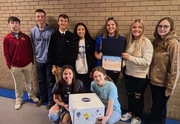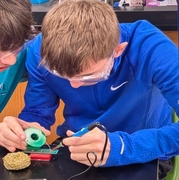Chemistry Class Wins National Experiment Proposal Competition
March 24, 2025
This past fall, Mr. K’s upper level science classes participated in the NASA Techrise Student Challenge. Of the three classes that participated, 1st Hour Chemistry, 8th Hour Chemistry, and Physics, 8th Hour Chemistry’s proposal was selected as a winner. In this competition, students had to submit a detailed experiment proposal for an experiment to be conducted on a high altitude air balloon flight later this year. Of the over 700 proposals received from schools around the United States and its territories, Mr. K’s 8th Hour Chemistry was 1 of 60 selected for a chance to develop their experiment and received an experimental spot on the World View High Altitude Air Balloon flight this summer! An example of one of these flights is pictured on the right. They also received a NASA Techrise winner’s box and $1500 to develop their experiment. Mr. K’s 8th Hour Chemistry Students include the following: Wyatt Sutton, Hunter Stenzel, Braddix Bozarth, Brynlin Schwindt, Hannah Younger, Jewel Hurst, Addison Christopher, Stephany Esparza, and Riya Young. If you see any of these students out in public, make sure to give them a, “Great job!” and ask them about how their NASA Techrise project is progressing! The team’s experiment proposal is detailed in the following paragraphs.
We plan on investigating the difference between aerogel insulation and styrofoam insulation. Insulation is important to maintain a suitable and liveable environment. The tropopause on average is -60°F and the very top of the stratosphere is 5°F, due to the large range of temperature insulation necessary. We want to find the best method to insulate the inside of the box, as the container travels through the stratosphere. Insulation reduces heat transfer by either reflecting thermal radiation or decreasing thermal conduction. We have a hypothesis for our method that is, “If we use aerogel as an insulator, then the environment inside the box will be more controlled than the styrofoam insulation.”
This experiment is important to our team so that we can help NASA and better our understanding of how the stratosphere affects the different types of insulators. Our team finds this project important so we can better understand how different insulators act in the stratosphere and troposphere. This is important to our school because we are a small school in rural western Kansas and we would love the chance to represent our community. Our school is not represented like this very often and this is a good chance for us to be.
Our team would learn the value of teamwork, how to get aerogel, and how different types of insulators work in different environments.
Our team can learn how to be a part of a greater cause, potentially better humanity, and learn how to use insulators in more than one way.
Our experiment will include our chemistry class 3D printing two different boxes to place inside of the box provided to us by NASA. The insulation will be placed between the walls of the 3D printed box. The temperature sensors, data logger, and microcontroller will be placed in the top of the NASA box to prevent any of that heat from tampering with the internal temperature of the two insulated boxes. We will be using 3 temperature sensors: one for box 1, one for box 2, and the last for measuring the atmospheric temperature, this one is the control temperature of this experiment. These temperature sensors are what we are using to measure the temperature in each box and the atmosphere, and this is the main data we are collecting. The microcontroller will be the brains of our experiment, controlling not only the temperature sensors but also the data logger. It will do this by telling the thermocouples when to turn on and the data logger when to start recording data.
The box above the empty space will be insulated with aerogel and the box beneath will be the box insulated by styrofoam. Both the styrofoam and aerogel will have the same thickness and amount. To stabilize these boxes we will be using plastic scaffolding.
In the data we are mostly focusing on the highest, lowest, and average temperatures in each box. Throughout our recording of the flight we will log our data onto a SIMS card in the data logger. With this data we will compare and analyze the temperatures that were measured to determine, which is a better insulator: styrofoam or aerogel. The data will also support or not support our hypothesis, that if we use aerogel as an insulator, then the environment inside the box will be more controlled than the box insulated with styrofoam. To support our hypothesis the aerogel insulated box will have less of a temperature range and maintain a higher temperature than the box insulated by styrofoam.
Over the spring semester, Mr. K’s 8th Hour Chemistry will be working weekly with NASA Techrise mentors and engineers to design and develop their experiment. During this process, students will learn about high altitude air balloons, experiment design, the engineering design process, computer coding, soldering, wiring, component mounting, and professional teamwork. The team is very excited and appreciative of this opportunity given to them. To give perspective, there are over 115,000 schools in the United States and its territories. This is an opportunity only given to 60 schools every year! Mr. K is very proud of his students and looks forward to leading this team in developing their experiment and taking their idea from concept to reality. He is excited for his students to have this rare opportunity to practice real science on a larger scale and for the memories that his students will make working on this project!



 Launch the media gallery 1 player
Launch the media gallery 1 player Launch the media gallery 2 player
Launch the media gallery 2 player